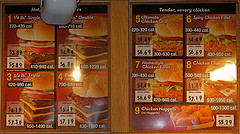Study: One In Five Menu Calorie Counts Are Off By At Least 100 Calories
As restaurant chains begin rolling out menus with calorie counts, one has to wonder just how accurate that information is. A new study claims that nearly one out of every five menu items underestimates by at least 100 calories, with some major chains like Boston Market and Chipotle missing the mark on some items by more than 200 calories.
The reports, published by Tufts University researchers in the Journal of the American Medical Association, labeled the calorie counts as “accurate overall,” since around 80% of the items it tested fell within that 100 calorie threshold.
Not surprisingly, fast food joints — with their more uniform menu items — were found to be “significantly” more accurate than full-service restaurant chains, where there are more variables involved in a menu item’s preparation. For example, an order of chips and salsa at On the Border Mexican Grill & Cantina was more than 1,000 calories higher than the restaurant claims in its nutrition info.
But some fast food items missed the mark by a mile.
From QSR Magazine:
In the study, Roberts and her colleagues found Chipotle’s burrito bowl with rice, black beans, peppers, onions, lettuce, green tomatillo salsa, and cheese had 703 total calories, which is 249 more than the estimate on the chain’s website. Three pieces of dark-meat chicken from Boston Market, meanwhile, had 215 more calories than advertised.
A Chipotle rep says that it’s difficult to put a hard and fast calorie number on its products: “In a service model like ours, the possibility of deviation always exists… We cook food — we don’t make widgets.”
For the study, researchers purchased menu items at restaurants and then took them back to the Tufts lab for analysis. The director of nutrition and healthy living for the National Restaurant Association (aka the other NRA), believes the fact that the food was packaged into to-go containers may have impacted the results.
“That to me is a huge influencer that could affect the large variance they found,” she tells QSR Magazine. “Perhaps the restaurants put more [food] in [the takeout containers] than they customarily serve on the plate when you go in and sit down. That could affect the caloric count. These things just weren’t controlled for.”
The study’s lead author says she is not claiming that restaurants deliberately misstate their calories, just that, up until now, “it hasn’t been something that people were making a big issue about. But now this paper is out, I hope they can improve substantially.”
The NRA counters that statement by saying that restaurants, “need to respond to a federal law, not necessarily to a study.”
Are Your Calorie Counts Right? [QSR Magazine]
Want more consumer news? Visit our parent organization, Consumer Reports, for the latest on scams, recalls, and other consumer issues.


